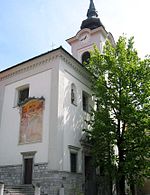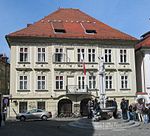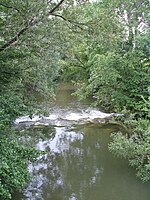St. James's Parish Church (Ljubljana)
1615 establishments in Europe17th-century Roman Catholic church buildings in SloveniaBaroque architecture in LjubljanaBaroque church buildings in SloveniaCenter District, Ljubljana ... and 2 more
Roman Catholic churches completed in 1615Roman Catholic churches in Ljubljana

St. James's Parish Church (Slovene: župnijska cerkev sv. Jakoba, šentjakobska cerkev) is a church in Ljubljana, the capital of Slovenia. It is dedicated to St. James the Greater. Its name is often incorrectly translated as St. Jacob's because Slovene, like many other languages, uses the same word for both James and Jacob. In the late 1920s, the square in front of the church was renovated by the Slovene architect Jože Plečnik, and in the early 1950s by the architect Boris Kobe. Opposite St. James's Church is Gruber Mansion, which houses the Slovenian National Archives.
Excerpt from the Wikipedia article St. James's Parish Church (Ljubljana) (License: CC BY-SA 3.0, Authors, Images).St. James's Parish Church (Ljubljana)
Levstikov trg, Ljubljana Trnovo
Geographical coordinates (GPS) Address External links Nearby Places Show on map
Geographical coordinates (GPS)
| Latitude | Longitude |
|---|---|
| N 46.046180555556 ° | E 14.507327777778 ° |
Address
Cerkev sv. Jakoba
Levstikov trg 2
1000 Ljubljana, Trnovo
Slovenia
Open on Google Maps








